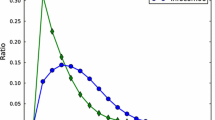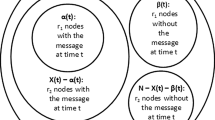Abstract
Opportunistic networks have attracted attention due to their inherent characteristics, such as long latency, low data rate, and intermittent connectivity. Extensive research has been conducted on opportunistic networks, including the architecture, and routing. However, few in the literature report the performance of TCP in opportunistic networks, especially in the case of Epidemic Routing. In this paper, we first evaluate the performance of TCP in opportunistic networks with Epidemic Routing. Our results show that the Epidemic Routing in opportunistic networks degrades the performance of TCP because multicopy data packets cause duplicate ACKs, and in turn reduce the transmission rate of TCP. Then an enhanced algorithm for TCP, named A-TCP/Reno is proposed to solve the above problem. A-TCP/Reno avoids the duplicate ACK problem caused by Epidemic Routing. The simulation results show that A-TCP/Reno outperforms the TCP/Reno in opportunistic networks with Epidemic Routing protocol.











Similar content being viewed by others
References
Pelusi, L., Passarella, A., & Conti, M. (2006). Opportunistic networking: data forwarding in disconnected mobile ad hoc network. IEEE Communications Magazine, 44(11), 134–141.
Fall, K. A delay-tolerant network architecture for challenged internets, Proceedings of ACM SIGCOMM, pp. 27–24, August 2003.
Juang, P., Oki, H., Wang, Y., Martonosi, M., Peh, L. S., & Rubenstein, D. (2002). Energy-efficient computing for wildlife tracking: Design tradeoffs and early experiences with ZebraNet. ACM SIGPLAN Notices, 37, 96–107.
Small, T., Haas, Z. J. (2003). The shared wireless infostation model: A new ad hoc networking paradigm (or where there is a whale, there is a way). Proceedings of the 4th ACM Int’l Symp on Mobile Ad Hoc Networking. Annapolis: ACM pp. 233–244.
Pan, H., Chaintreau, A., Scott, J., Gass, R., Cmwcoft, J., and Diot, C. (2005). Pocket switched networks and human mobility in conference environments. Proceedings of the 2005 ACM SIGCOMM work shop on Delay-Tolerant Networking. Philadelphia: ACM.
Hun, B., Bychkovsky, V., Zhallg, Y., Chen, K., Goraczko, M., Miu, A, Shm, E., Balakrishnan, H., and Madden, S. (2006). CarTel: A distributed mobile sensor computing system. Proceedings of the 4th Int’l Conf on Embedded Networked Senson Systems. Boulder: ACM pp. 125–138.
Pentland, A., Fletcher, R., & Hasson, A. (2004). DakNet: Rethinking connectivity in developing nations. IEEE Computer, 37(1), 78–83.
Conti, M., & Giordano, S. (2007). Multihop ad hoc networking: The reality. Communications Magazine, 45(4), 88–95.
Fall, K., & Farrell, S. (2008). DTN: An architectural retrospective. Journal of Selected Areas in Communications, 26(5), 828–836.
Cerf, V., Burleigh, S., Hooke, A., Torgerson, L., Durst, R., Scott, K., Fall, K., and Weiss, H. Delay–tolerant networking architecture. Internet RFC4838, April 2007.
Akyildiz, I. F., Akan, Ö. B., Chen, C., Fang, J., & Su, W. (2003). InterPlaNetary Internet: state-of-the-art and research challenges. Computer Networks, 43, 75–112.
Sushant, J., Fall, K., Patra, R. Routing in a delay tolerant network. Proceedings of ACM SIGCOMM 2004, August 2004.
Vahdat, A. & Becker, D. Epidemic routing for partially connected ad hoc networks. Technical Report CS-200006, Duke University, April 2000.
Lindgren, A., Doria, A., & Schelen, O. (2003). Probabilistic routing in intermittently connected networks. SIGMOBILE Mobile Computing Communication Review, 7(3), 19–20.
Spyropoulos, T., Psounis, K., Raghavendra, C. S. Spray and wait: An efficient routing scheme for intermittently connected mobile networks. Proceeding of ACM SIGCOMM 2005, Philadelphia, PA, USA, August 2005.
Jin, Z., Zhao, X., Luo, Y. Zhao, D. Adaptive Priority Routing with Ack_Mechanism for DTN networks. Proceedings of Wireless Communications & Signal Processing, 2009.Nanjing: China, pp. 1–5, Nov. 2009.
Subramanian, R., Fekri, F. Throughput analysis of delay tolerant networks with finite buffers. Proceedings of 5th IEEE International Conference on Mobile Ad Hoc and Sensor Systems, 2008. Atlanta: GA, pp. 790–795, Oct. 2008.
Johnson, D., Maltz, D., Hu, Y. -C., & Jetcheva, J. The dynamic source routing protocol for mobile ad hoc networks (DSR). IETF Internet Draft, draft-ietf-manet-dsr-06.txt, November 2001.
Allman, M., Paxson, V., & Stevens, W. TCP Congestion Control. RFC 2581, April 1999.
Jindal, A., & Psounis, K. (2006). Performance analysis of epidemic routing under contention. ACM IWCMC: Proceedings of.
Li, Y., Lei, S., You, X. (2010). Performance of TCP in intermittently connected wireless networks: Analysis and improvement. Proceedings of the 2010 IEEE Global Telecommunications Conference. Miami: IEEE Press.
Acknowledgment
This paper is supported by the National Science Foundation of China (60702055), Program for New Century Excellent Talents in University (NCET-07-0914), China Postdoctoral Science Foundation (20090451158).
Author information
Authors and Affiliations
Corresponding author
Rights and permissions
About this article
Cite this article
Li, Y., You, X., Lei, S. et al. Analysis and improvement of TCP performance in opportunistic networks. Wireless Netw 18, 799–810 (2012). https://doi.org/10.1007/s11276-012-0434-3
Published:
Issue Date:
DOI: https://doi.org/10.1007/s11276-012-0434-3




